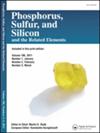Silicon’s defensive role against biotic and abiotic stress: a review
IF 1.4
4区 化学
Q4 CHEMISTRY, INORGANIC & NUCLEAR
Phosphorus, Sulfur, and Silicon and the Related Elements
Pub Date : 2025-04-03
DOI:10.1080/10426507.2025.2482090
引用次数: 0
Abstract
Silicon enhances developmental processes and controls the enzymatic and functional properties of plants. It is considered a quasi-element in the earth’s crust, absorbed and translocated to aerial parts through transpiration. Silicon reduces various plant stress conditions, with plants displaying both direct and indirect defensive mechanisms. Indirect defense involves the release of volatiles that attract the pathogen’s natural enemies, while morphological, biochemical, and molecular impediments constitute direct defense. Both mechanisms are strengthened by silicon treatment. Silicon enhances the polymerization of silicic acid in intercellular spaces and beneath cuticles as phytoliths, establishing a defense against pathogens. Silicon activates multiple pathways, encouraging the accumulation of supplementary metabolites, thereby enhancing plant defenses against abiotic and biotic challenges. It also contributes significantly to defensive mechanisms mediated by phytohormones. Studies show that silicon positively affects plants during severe stress by modifying several metabolites. Phytohormones are essential to crop plants’ biochemical and physiological functions under unfavorable environmental circumstances. Frontline phytohormones, such as auxin, cytokinin, ethylene, gibberellin, salicylic acid, abscisic acid, brassinosteroids, and jasmonic acid regulate abiotic stress tolerance pathways intrinsically linked with silicon. This review highlights silicon’s functionality in various biotic and abiotic stresses.
硅对生物和非生物胁迫的防御作用综述
硅促进了植物的发育过程,控制了植物的酶和功能特性。它被认为是地壳中的一种准元素,通过蒸腾作用被吸收并转移到空中。硅降低了植物的各种胁迫条件,植物表现出直接和间接的防御机制。间接防御包括释放挥发性物质吸引病原体的天敌,而形态、生化和分子障碍则构成直接防御。硅处理强化了这两种机制。硅增强了硅酸在细胞间隙和角质层下作为植物岩的聚合,建立了对病原体的防御。硅激活多种途径,促进补充代谢物的积累,从而增强植物对非生物和生物挑战的防御。它还对植物激素介导的防御机制有重要作用。研究表明,在严重的逆境中,硅通过改变几种代谢物对植物产生积极影响。植物激素是作物在不利环境下发挥生理生化功能所必需的激素。一线植物激素,如生长素、细胞分裂素、乙烯、赤霉素、水杨酸、脱落酸、油菜素类固醇和茉莉酸调节与硅内在相关的非生物胁迫耐受途径。本文综述了硅在各种生物和非生物胁迫下的功能。
本文章由计算机程序翻译,如有差异,请以英文原文为准。
求助全文
约1分钟内获得全文
求助全文
来源期刊
CiteScore
2.60
自引率
7.70%
发文量
103
审稿时长
2.1 months
期刊介绍:
Phosphorus, Sulfur, and Silicon and the Related Elements is a monthly publication intended to disseminate current trends and novel methods to those working in the broad and interdisciplinary field of heteroatom chemistry.

 求助内容:
求助内容: 应助结果提醒方式:
应助结果提醒方式:


